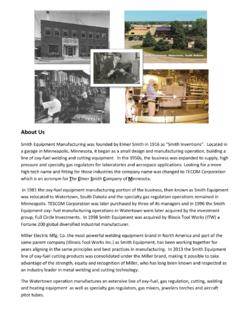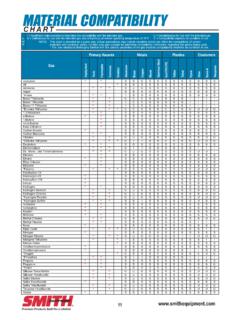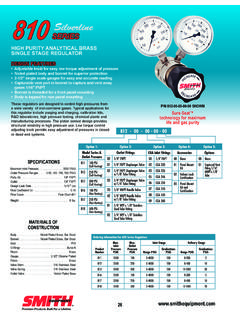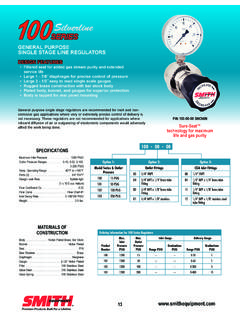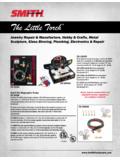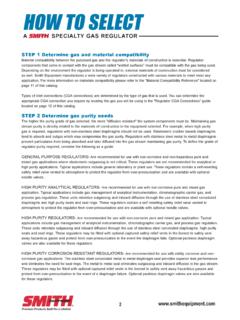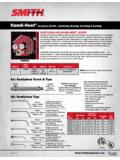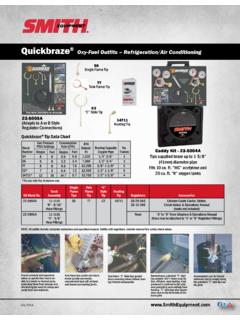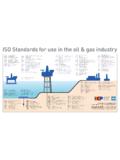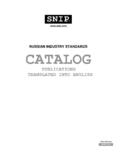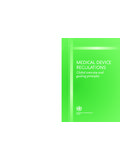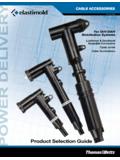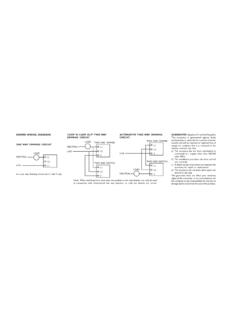Transcription of Pressure Regulators - Smith Equipment
1 File: AccessoryOM-263 230A2013 06 ProcessesOxy-FuelGas RegulationSAFETY MANUALForm 4322 Rev 2013-06 Pressure RegulatorsSpecialty GasInertHigh PressureLiquid CylinderTABLE OF CONTENTSSECTION 1 SAFETY PRECAUTIONS - READ BEFORE , Cutting, Brazing, Heating Proposition 65 Safety 2 3 HAZARDOUS 4 HAZARDS OF RECOMPRESSING PURE 5 SPECIALTY GASES On Compressed 6 PRE-INSTALLATION PROCEDURES: 7 INSTALLATION AND 8 SYSTEM 9 PERFORMANCE 10 CARE AND 230 Page 1 SECTION 1 SAFETY PRECAUTIONS -READ BEFORE USINGOXY FUEL 2013-06 Protect yourself and others from injury read, follow, andsave these important safety precautions and operating Symbol UsageDANGER!
2 Indicates a hazardous situation which, if notavoided, will result in death or serious injury. The possiblehazards are shown in the adjoining symbols or explainedin the a hazardous situation which, if not avoided,could result in death or serious injury. The possible haz-ards are shown in the adjoining symbols or explained inthe Indicates statements not related to personal special group of symbols meansWarning! Watch Out! ELECTRICSHOCK, MOVING PARTS, andHOT PARTS hazards. Consultsymbols and related instructions below for necessary actions to avoidthe Welding, Cutting, Brazing, Heating HazardsThe symbols shown below are used throughout this manualto call attention to and identify possible hazards.
3 When yousee the symbol, watch out, and follow the related instructionsto avoid the hazard. The safety information given below isonly a summary of the more complete safety informationfound in the Safety Standards listed in Section 1-4. Read andfollow all Safety qualified persons should install, operate, maintain, andrepair this operation, keep everybody, especially children, not use this Equipment unless you are trained in its properuse or are under competent supervision. Follow the proced-ures described in this booklet every time you use the equip-ment.
4 Failure to follow these instructions may cause fire, ex-plosion, asphyxiation, property damage, or personal Equipment must be used in accordance with all Federal,State, and local regulations as well as DOT (Department ofTransportation) and CGA (Compressed Gas Association) reg-ulations. Contact your gas supplier for more information onthe proper use of compressed this document, the phrase welding and cutting also refers to oth-er oxy-fuel operations like brazing and 230 Page 2 READ and follow all labels and the Owner s Manual carefully be-fore installing, operating, or servicing Equipment .
5 Read the safetyinformation at the beginning of the manual and in each only genuine replacement parts from the maintenance and service according to the Owner sManuals, industry standards, and national, state, and local PARTS can not touch hot parts bare cooling period before working on handle hot parts, use proper tools and/or wear heavy, insu-lated welding gloves and clothing to prevent AND GASES can be and cutting produces fumes and gases. Breathing thesefumes and gases can be hazardous to your your head out of the fumes.
6 Do not breathe the inside, ventilate the area and/or use local forced ventilation atthe flame to remove welding and cutting fumes and gases. Somegases (natural gas and acetylene) are lighter than air and will col-lect in high areas. Other gases (propane and butane) are heavierthan air and will collect in low areas. Heavier-than-air gases aremore difficult to diffuse and are more likely to ventilation is poor, wear an approved air-supplied and understand the Material Safety Data Sheets (MSDSs)and the manufacturer s instructions for metals, consumables,coatings, cleaners, and in a confined space only if it is well ventilated, or whilewearing an air-supplied respirator.
7 Always have a trained watch-person nearby. Welding and cutting fumes and gases can dis-place air and lower the oxygen level, causing injury or death. Besure the breathing air is safe. Test atmospheres in confined areasfor explosive and toxic gases before using oxy-fuel not weld or cut in locations near degreasing, cleaning, orspraying operations. The heat from welding or cutting flame canreact with vapors to form highly toxic and irritating not weld or cut on coated metals, such as galvanized, lead, orcadmium-plated steel unless the coating is removed from the af-fected area, the area is well ventilated, and while wearing an air-supplied respirator.
8 The coatings and any metals containingthese elements can give off toxic fumes if welded or not weld or cut on sealed air conditioning or refrigeration sys-tems unless all refrigerants have been removed from the off compressed gas supply when not in ventilate confined spaces or use approved air-suppliedrespirator. BUILDUP OF GAS can injure or 230 Page 3 Light rays from the welding and cutting process produce intense visibleand invisible (ultraviolet and infrared) rays that can burn eyes and fly off from the approved face protection fitted with a proper shade of filterlenses to protect your face and eyes from light rays and sparkswhen welding, cutting, or watching (see ANSI and in Safety Standards).
9 DWear welding goggles, or wear welding helmet/welding face-shield over approved goggles/safety glasses with side protective screens or barriers to protect others from flash,glare and sparks; warn others not to watch the welding or protective clothing made from durable, flame-resistantmaterial (leather, heavy cotton, or wool) and foot RAYS can burn eyes and and cutting on closed containers, such as tanks, drums, orpipes, can cause them to blow up. Sparks can fly off from the welding orcutting operations. The flying sparks, hot workpiece, and hot equipmentcan cause fires and burns.
10 Check and be sure the area is safe beforedoing any welding or AND CUTTING can causefire or not use this welding and cutting Equipment with gases andpressures other than those for which it is intended. Oxygen is notflammable; however, the presence of pure oxygen will drasticallyincrease the speed and force with which burning takes place. Oxy-gen must never be allowed to contact grease, oil, or other petro-leum-based substances; therefore, be sure there is no oil or greaseon the regulator, cylinder, valves, or Equipment . Do not use petro-leum-based pipe sealants.
